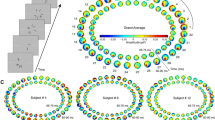Abstract
Visual evoked potentials have been proposed by some researchers to be more useful than behavioral techniques to evaluate stereo performance in children and certain clinical populations. Stimulus duration detection thresholds, visual evoked potentials, and scalp electrical potential distribution maps to dynamic random dot stereograms were studied. A high degree of correspondence was found between visual evoked potential amplitudes and behaviorally determined detection thresholds. Upper field stimuli had higher detection thresholds and generated lower-amplitude visual evoked potential responses than did centrally presented stimuli. For the most eccentrically presented stimuli, lower detection thresholds were found for stimuli presented in the right visual field than the left visual field. This finding was consistent with the pattern of VEP responses to be lateralized, with higher-amplitude responses recorded over left-hemisphere sites. The study examined a proposal that the major negative component of the stereoscopic visual evoked potential originates in cortical area VI. The results failed to support the proposal and were consistent with the main negative component of the VEP being generated in V2, rather than V1.
Similar content being viewed by others
Abbreviations
- DRDS:
-
dynamic random dot stereogram
References
Wheatstone C. On remarkable and hitherto unobserved, phenomena of binocular vision. Phil Trans R Soc Lond 1938; 128: 317–94.
Breitmeyer B, Julesz B, Kropfl W. Dynamic random-dot stereograms reveal up-down anisotropy and left-right isotropy between cortical hemifields. Science 1975; 187: 260–70.
Finlay DC, Manning ML, Dunlop DB, Dewis SAM. Temporal detection thresholds to crossed and uncrossed disparity dynamic random dot stereograms. Doc Ophthalmol 1989; 72: 161–73.
Julesz B, Breitmeyer B, Kropfl W. Binocular disparity-dependent upper-lower hemifield anisotropy and left-right isotropy as revealed by random dot stereograms. Perception 1976; 5: 129–41.
Manning ML, Finlay DC, Neill RA, Frost BG. Detection thresholds differences to crossed and uncrossed disparities. Vision Res 1987; 27: 1683–6.
Julesz B. Binocular depth perception of computer generated patterns. Bell Syst Tech J 1960; 39: 1125–62.
Julesz B. Foundations of cyclopean perception. Chicago: University of Chicago Press, 1971.
Stone J, Leicester J, Sherman SM. The naso-temporal division of the monkey retina. J Comp Neurol 1973; 150: 333–48.
Julesz B, Kropfl W. Binocular neurons and cyclopean visually evoked potentials in monkey and man. Ann NY Acad Sci 1982; 338: 37–44.
Petrig B, Julesz B, Lehmann D, Lang J. Assessment of stereopsis in infants and children using dynamic random dot pattern evoked potentials. Doc Ophthalmol Proc Ser 1982; 31: 477–82.
Poggio GF, Motter BC, Squattrio S, Trotter Y. Responses of neurons in the visual cortex (V1 & V2) of the alert macaque to dynamic random dot stereograms. Vision Res 1985; 25: 397–406.
Baizer JS, Robinson DL, Dow BM. Visual response of area 18 neurons in awake, behaving monkey. J Neurophysiol 1977; 40: 1024–37.
Zeki SM. Convergent input from the striate cortex (area 17) to the cortex of the superior temporal sulcus in the rhesus monkey. Brain Res 1971; 28: 338–40.
Zeki SM. Colour coding in the superior temporal sulcus of the rhesus monkey temporal cortex. Proc R Soc Lond B 1977; 197: 195–223.
Neill RA, Fenelon B. Scalp response topography to dynamic random dot stereograms. Electroencephalogr Clin Neurophysiol 1988; 69: 209–17.
Brindley GS. The variability of the human striate cortex. J Physiol 1972; 225: 1–3P.
Stensaas SS, Eddington DK, Dobelle WH. The topography and variability of the primary visual cortex in man. J Neurosurg 1974; 40: 747–55.
Blumhardt LD, Barrett G, Halliday AM. The asymmetrical visual evoked potential to pattern reversal in one half field and its significance for the analysis of visual field defects. Br J Ophthalmol 1977; 61: 454–61.
Neill RA, Fenelon B. The objective evaluation of stereopsis. Aust Phys Eng Sci Med 1981; 4: 122–5.
Neill RA, Kennewell JA. A clinical test for stereopsis. Aust Phys Eng Sci Med 1979; 2: 463–80.
Teping C, Silny J. Evidence of pericentral stereopsis in random dot VECP. Doc Ophthalmol 1987; 66: 261–6.
Dixon WJ. BMDP statistical software. Berkeley, Calif: University of California Press, 1981.
MacDougall EB. Computer programming for spatial problems. London: Edward Arnold, 1976.
Hallett PE. Eye movements. In: Boff KR, Kaufman L, Thomas JP, eds. Handbook of perception and human performance, Vol. 1: Sensory processes and perception. New York: John Wiley, 1986.
Author information
Authors and Affiliations
Rights and permissions
About this article
Cite this article
Manning, M.L., Finlay, D.C., Dewis, S.A.M. et al. Detection duration thresholds and evoked potential measures of stereosensitivity. Doc Ophthalmol 79, 161–175 (1992). https://doi.org/10.1007/BF00156575
Accepted:
Issue Date:
DOI: https://doi.org/10.1007/BF00156575




